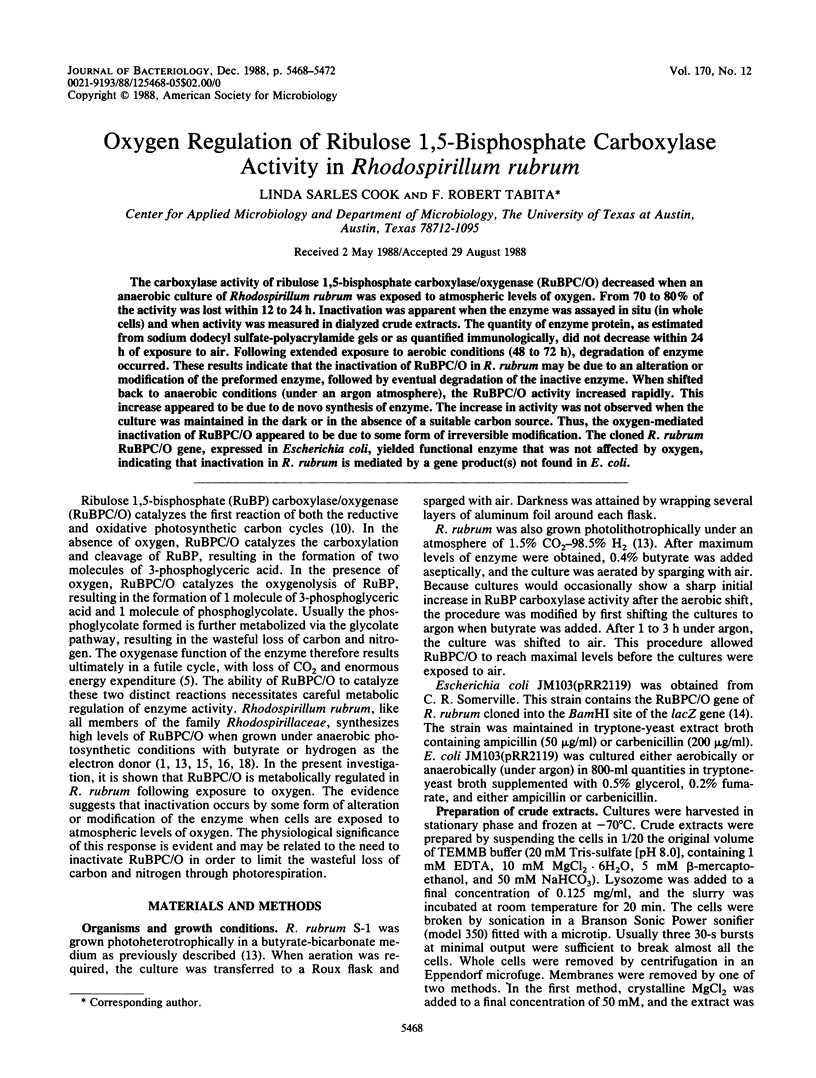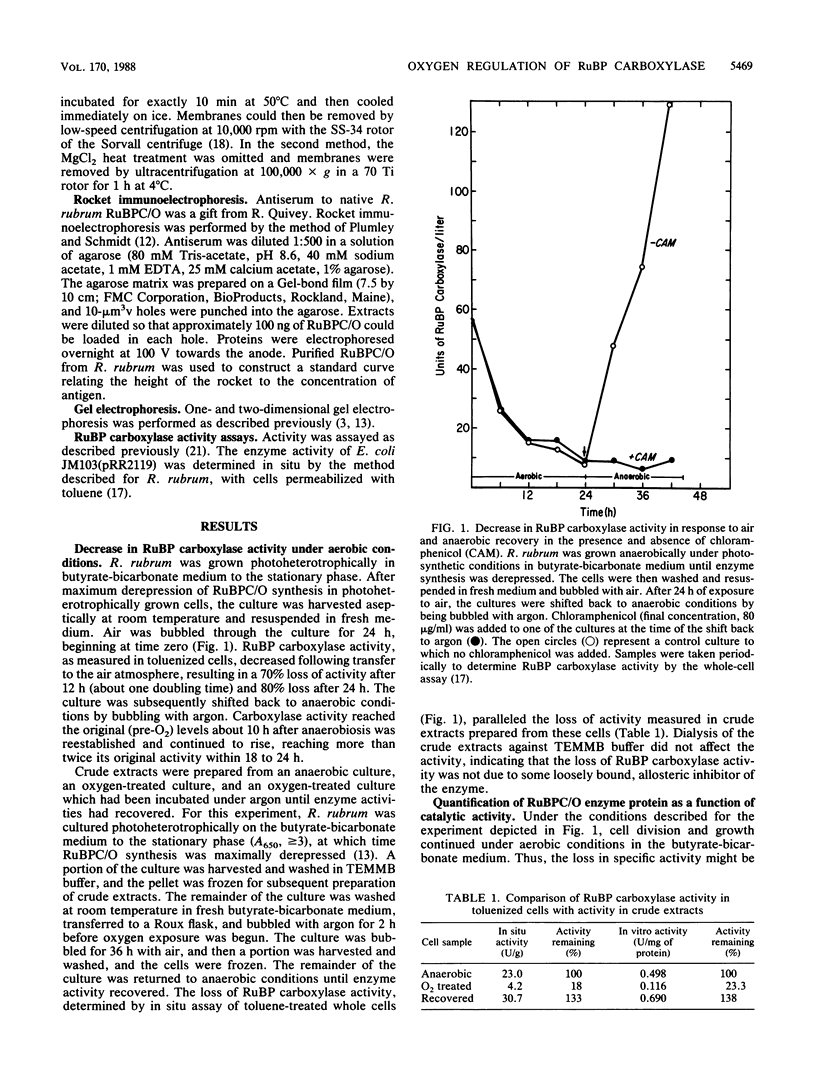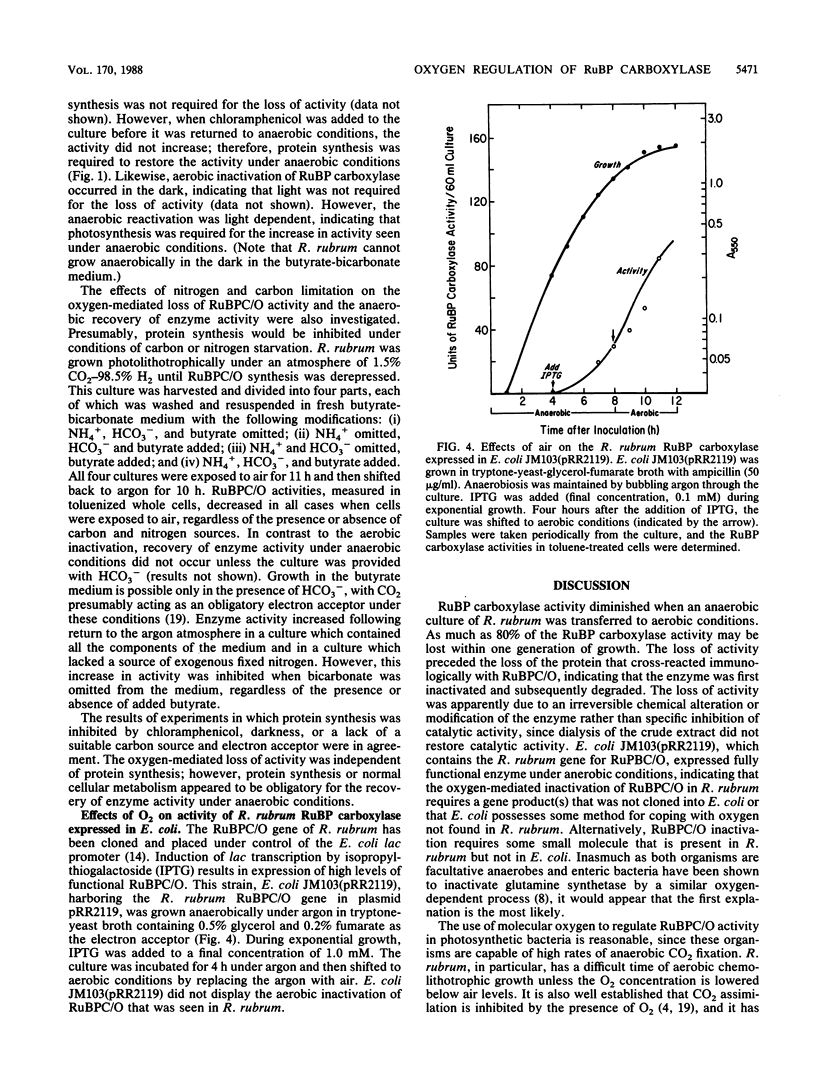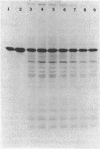Abstract
The carboxylase activity of ribulose 1,5-bisphosphate carboxylase/oxygenase (RuBPC/O) decreased when an anaerobic culture of Rhodospirillum rubrum was exposed to atmospheric levels of oxygen. From 70 to 80% of the activity was lost within 12 to 24 h. Inactivation was apparent when the enzyme was assayed in situ (in whole cells) and when activity was measured in dialyzed crude extracts. The quantity of enzyme protein, as estimated from sodium dodecyl sulfate-polyacrylamide gels or as quantified immunologically, did not decrease within 24 h of exposure to air. Following extended exposure to aerobic conditions (48 to 72 h), degradation of enzyme occurred. These results indicate that the inactivation of RuBPC/O in R. rubrum may be due to an alteration or modification of the preformed enzyme, followed by eventual degradation of the inactive enzyme. When shifted back to anaerobic conditions (under an argon atmosphere), the RuBPC/O activity increased rapidly. This increase appeared to be due to de novo synthesis of enzyme. The increase in activity was not observed when the culture was maintained in the dark or in the absence of a suitable carbon source. Thus, the oxygen-mediated inactivation of RuBPC/O appeared to be due to some form of irreversible modification. The cloned R. rubrum RuBPC/O gene, expressed in Escherichia coli, yielded functional enzyme that was not affected by oxygen, indicating that inactivation in R. rubrum is mediated by a gene product(s) not found in E. coli.
Full text
PDF




Images in this article
Selected References
These references are in PubMed. This may not be the complete list of references from this article.
- Anderson L., Fuller R. C. Photosynthesis in Rhodospirillum rubrum. 3. Metabolic control of reductive pentose phosphate and tricarboxylic acid cycle enzymes. Plant Physiol. 1967 Apr;42(4):497–509. doi: 10.1104/pp.42.4.497. [DOI] [PMC free article] [PubMed] [Google Scholar]
- Cook L. S., Im H., Tabita F. R. Oxygen-dependent inactivation of ribulose 1,5-bisphosphate carboxylase/oxygenase in crude extracts of Rhodospirillum rubrum and establishment of a model inactivation system with purified enzyme. J Bacteriol. 1988 Dec;170(12):5473–5478. doi: 10.1128/jb.170.12.5473-5478.1988. [DOI] [PMC free article] [PubMed] [Google Scholar]
- Jouanneau Y., Tabita F. R. Independent regulation of synthesis of form I and form II ribulose bisphosphate carboxylase-oxygenase in Rhodopseudomonas sphaeroides. J Bacteriol. 1986 Feb;165(2):620–624. doi: 10.1128/jb.165.2.620-624.1986. [DOI] [PMC free article] [PubMed] [Google Scholar]
- Levine R. L., Oliver C. N., Fulks R. M., Stadtman E. R. Turnover of bacterial glutamine synthetase: oxidative inactivation precedes proteolysis. Proc Natl Acad Sci U S A. 1981 Apr;78(4):2120–2124. doi: 10.1073/pnas.78.4.2120. [DOI] [PMC free article] [PubMed] [Google Scholar]
- Levine R. L. Oxidative modification of glutamine synthetase. I. Inactivation is due to loss of one histidine residue. J Biol Chem. 1983 Oct 10;258(19):11823–11827. [PubMed] [Google Scholar]
- Levine R. L. Oxidative modification of glutamine synthetase. II. Characterization of the ascorbate model system. J Biol Chem. 1983 Oct 10;258(19):11828–11833. [PubMed] [Google Scholar]
- Madigan M. T., Gest H. Growth of the photosynthetic bacterium Rhodopseudomonas capsulata chemoautotrophically in darkness with H2 as the energy source. J Bacteriol. 1979 Jan;137(1):524–530. doi: 10.1128/jb.137.1.524-530.1979. [DOI] [PMC free article] [PubMed] [Google Scholar]
- Miziorko H. M., Lorimer G. H. Ribulose-1,5-bisphosphate carboxylase-oxygenase. Annu Rev Biochem. 1983;52:507–535. doi: 10.1146/annurev.bi.52.070183.002451. [DOI] [PubMed] [Google Scholar]
- Ogren W. L., Bowes G. Ribulose diphosphate carboxylase regulates soybean photorespiration. Nat New Biol. 1971 Mar 31;230(13):159–160. doi: 10.1038/newbio230159a0. [DOI] [PubMed] [Google Scholar]
- Plumley F. G., Schmidt G. W. Rocket and crossed immunoelectrophoresis of proteins solubilized with sodium dodecyl sulfate. Anal Biochem. 1983 Oct 1;134(1):86–95. doi: 10.1016/0003-2697(83)90267-1. [DOI] [PubMed] [Google Scholar]
- Sarles L. S., Tabita F. R. Derepression of the synthesis of D-ribulose 1,5-bisphosphate carboxylase/oxygenase from Rhodospirillum rubrum. J Bacteriol. 1983 Jan;153(1):458–464. doi: 10.1128/jb.153.1.458-464.1983. [DOI] [PMC free article] [PubMed] [Google Scholar]
- Tabita F. R., Caruso P., Whitman W. Facile assay of enzymes unique to the Calvin cycle in intact cells, with special reference to ribulose 1,5-bisphosphate carboxylase. Anal Biochem. 1978 Feb;84(2):462–472. doi: 10.1016/0003-2697(78)90064-7. [DOI] [PubMed] [Google Scholar]
- Tabita F. R., McFadden B. A. D-ribulose 1,5-diphosphate carboxylase from Rhodospirillum rubrum. I. Levels, purification, and effects of metallic ions. J Biol Chem. 1974 Jun 10;249(11):3453–3458. [PubMed] [Google Scholar]
- Tabita F. R. Molecular and cellular regulation of autotrophic carbon dioxide fixation in microorganisms. Microbiol Rev. 1988 Jun;52(2):155–189. doi: 10.1128/mr.52.2.155-189.1988. [DOI] [PMC free article] [PubMed] [Google Scholar]
- Whitman W., Tabita F. R. Inhibition of D-ribulose 1,5-bisphosphate carboxylase by pyridoxal 5'-phosphate. Biochem Biophys Res Commun. 1976 Aug 23;71(4):1034–1039. doi: 10.1016/0006-291x(76)90758-0. [DOI] [PubMed] [Google Scholar]



